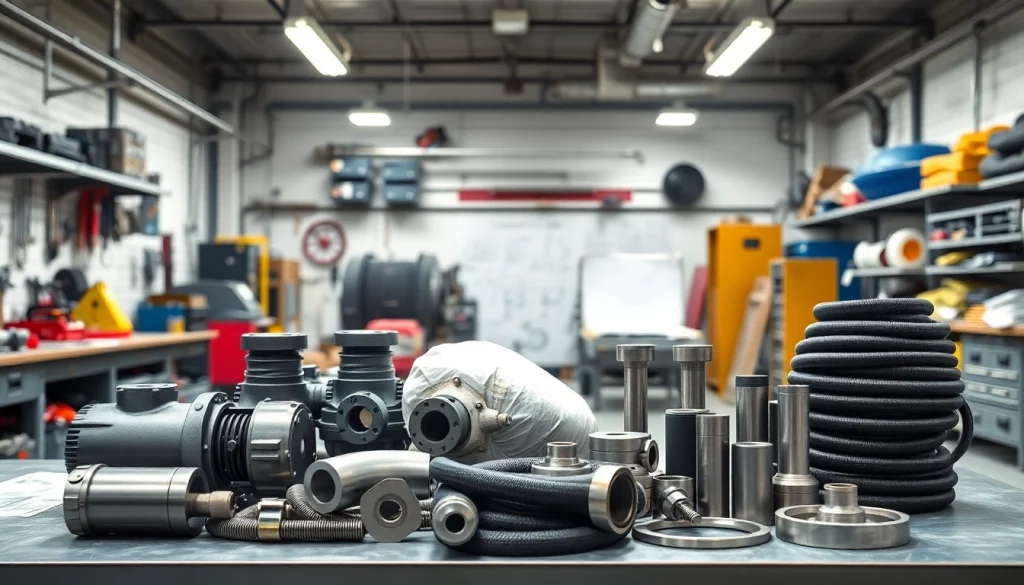1. Understanding Concrete Pump Spare Parts
1.1 What are Concrete Pump Spare Parts?
Concrete pump spare parts are components specifically designed to replace or repair worn-out or damaged parts of concrete pumps. These pumps are essential machinery in construction projects, responsible for transporting liquid concrete to various locations quickly and efficiently. As with any machinery, regular wear and tear can affect performance, leading to the need for replacement parts. The correct selection and replacement of these spare parts are critical for maintaining optimal pump operation and ensuring project timelines are met.
1.2 Importance of Quality Spare Parts
The importance of using high-quality spare parts cannot be overstated. Quality components help minimize downtime, reduce maintenance costs, and extend the overall life of the concrete pump. Inferior parts may not only fail prematurely but can also cause damage to other critical components, leading to more extensive and costly repairs. When choosing spare parts, it is vital to consider those that adhere to the manufacturer’s specifications and guidelines, ensuring compatibility and reliability.
1.3 Types of Concrete Pump Spare Parts
Concrete pump spare parts come in various types, each serving a unique function. Some common categories include:
- Wear Parts: These include items such as piston cups, wear plates, and hoses that undergo significant wear during operation.
- Hydraulic Components: Hydraulic pumps, filters, and cylinders that help in the pumping process.
- Electrical Parts: This includes sensors, controllers, and wiring harnesses essential for the motor’s operation.
- Structural Components: Boom sections, elbows, and pipes that aid in the movement and placement of concrete.
2. Common Issues with Concrete Pump Parts
2.1 Identifying Wear and Tear
One of the significant challenges faced by operators is identifying wear and tear before it leads to severe problems. Signs of wear may include increased noise during operation, reduced pumping efficiency, or visible deterioration of parts. Regular inspections can help in identifying issues early, allowing for timely replacement of worn parts.
2.2 Recognizing Symptoms of Malfunction
Concrete pumps may exhibit various symptoms when malfunctioning. Operators should be aware of:
- Poor Concrete Flow: Inconsistent or hesitant flow of concrete may indicate issues with the pumping mechanism.
- Excessive Heat: Overheating during operation can be a sign of hydraulic fluid issues or component failure.
- Short Circuiting: This symptom often presents itself through electrical failures that can be traced back to faulty wiring or components.
2.3 Troubleshooting Common Problems
Troubleshooting common issues requires a systematic approach. Operators should have a clear checklist for diagnosing problems:
- Check hydraulic fluid levels and quality.
- Inspect pumps for leaks or cracks.
- Examine electrical connections and fuses for integrity.
Having a diagnostic plan in place enables quicker resolutions and prevents downtime.
3. How to Choose the Right Spare Parts
3.1 Sourcing Genuine Spare Parts
Sourcing genuine spare parts is crucial for maintaining the integrity and performance of concrete pumps. Genuine parts adhere to industry standards and specifications set by pump manufacturers. Avoiding counterfeit part suppliers helps prevent subpar performance and enhances safety on job sites.
3.2 Compatibility with Different Pump Models
When selecting spare parts, considering the compatibility with the specific pump model is essential. Different pumps may have varying specifications, and using parts designed for other models can lead to performance issues or even damage. Consult the manufacturer’s specifications or a trusted supplier when uncertain about compatibility.
3.3 Comparing Cost and Quality
While cost is an important factor, it should not be the sole consideration when selecting spare parts. High-quality parts may come at a slightly higher price but often lead to lower overall costs due to their durability and reliability. Compare warranties, customer reviews, and brand reputations to make informed decisions on cost versus quality.
4. Maintenance Tips for Concrete Pumps
4.1 Regular Inspections and Testing
Implementing regular inspections and testing schedules helps ensure the smooth operation of concrete pumps. It is advisable to conduct daily checks before operation and comprehensive inspections at regular intervals. Key checks include:
- Hydraulic fluid levels and condition
- Wear on critical components such as hoses and seals
- Functionality of electronic controls
4.2 Preventative Maintenance Practices
Preventative maintenance includes adhering to a scheduled service plan. Key aspects include:
- Changing hydraulic oil and filters according to manufacturer recommendations.
- Regularly greasing moving parts to reduce friction and wear.
- Scheduling professional services to calibrate and maintain pump performance.
4.3 Signs That Spare Parts Need Replacement
Recognizing the signs that spare parts need replacement is crucial for minimizing downtime. Look for manifestations such as:
- Excessive vibration during operation
- Frequent fuses blowing in the electrical system
- Unusual noises or grinding sounds
Addressing these symptoms promptly can prevent larger, more costly repairs in the future.
5. Where to Buy Concrete Pump Spare Parts
5.1 Online vs. In-Store Purchases
When considering where to buy concrete pump spare parts, both online and in-store shopping have their advantages. Online purchasing allows for a wider selection, competitive pricing, and convenience. However, in-store shopping provides immediate access to parts and allows for direct consultation with experts. Depending on urgency and specificity, one may be preferred over the other.
5.2 Reputable Suppliers and Manufacturers
To ensure the acquisition of high-quality spare parts, it’s crucial to select reputable suppliers and manufacturers. Look for established companies with a proven track record in the industry. They often provide warranties and customer support, which can be invaluable. It’s also beneficial to check if they carry a range of parts for different model pumps, such as concrete pump spare parts, for major brands.
5.3 Evaluating Customer Reviews and Ratings
Before making a purchase, evaluating customer reviews and ratings can provide insights into the quality and reliability of the parts and the seller. Look for consistent feedback regarding product performance, customer support, and shipment efficiency. Online review platforms and construction forums can serve as valuable sources of information.


